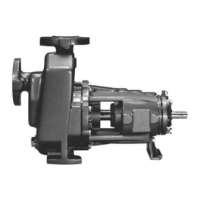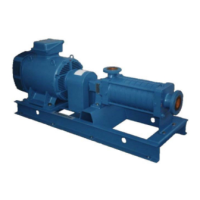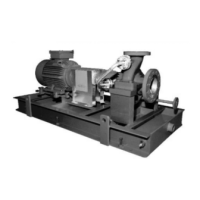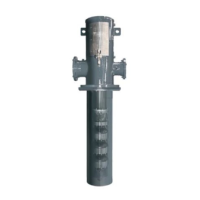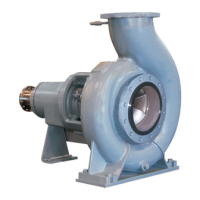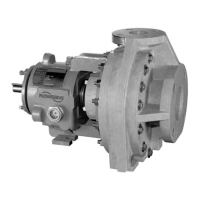CS USER INSTRUCTIONS ENGLISH 10.06.77.10986 - 12/05
Page 16 of 66
®
4 INSTALLATION
It is strongly recommended the
installation and commissioning of this equipment be
conducted in accordance with API Recommended
Practices 686/PIP REIE 686 First Edition. Refer to
API 610 Eighth Edition Appendix 'L' for baseplate
[6110] grouting requirements; see 10.3.
The following ASTM Specifications are
furnished as references for test methods used in
conjunction with installation of grouting materials and
should be used to obtain proper results; see 10.3.
• ASTM C 78-84: Test Method for Flexural Strength
for Concrete
• ASTM C 109-90: Test Method for Compressive
Strength of Hydraulic Cement Mortars (Modified)
• ASTM C 469 87a: Test Method for Static Modulus
of Elasticity and Poisson's Ratio of Concrete in
compression
• ASTM C 496-90: Test Method for Splitting Tensile
Strength of Cylindrical Concrete Specimens
• ASTM C 531-85: Test Method for Linear
Shrinkage and Coefficient of Thermal Expansion
of Chemical Resistant Grouts and Monolithic
Surfacings (Modified)
• ASTM C 666-90: Test Method for Resistance of
Concrete to Rapid Freezing and Thawing
• ASTM C 939-87: Test Method for Flow of Grout
for Preplaced Aggregate Concrete (Flow Cone
Method)
• ASTM C 942-86: Test Method for Compressive
Strength of Grouts for Preplaced Aggregate
Concrete in the Laboratory
• ASTM C 1090-88: Test Method for Measuring
Changes in Height of Cylindrical Specimens from
Hydraulic Cement Grout
• ASTM C 1107-91: Standard Specification for
Packaged Hydraulic Cement Grout (Non shrink)
• (CRD C 621-92) ACI 351 24 Hour Test: Grouting
for Support of Equipment and Machinery. MBT
Test Method for Grout Performance
Minimum requirements for epoxy grout (typical
properties at 23 °C (73 °F):
• ASTM D-635: Fire Resistant
• ASTM C-579B: Minimum Compressive Strength
82.7 N/mm
2
(12000 psi)
• ASTM C-827: Height Change @ 38 °C (90 °F).
Positive Effective Bearing Area 95%
• ASTM C-1181: Maximum Creep in 1 Year 1.6X10
-
3
mm/mm (in./in.) at 60 ºC (140 °F), 2.76 N/mm
2
(400 psi)
• ASTM C-307. Minimum Tensile Strength 12.4
N/mm
2
(1800 psi)
• ASTM C-580. Minimum Flexural Strength 26.2
N/mm
2
(3800 psi)
• ASTM C-580. Minimum Flexural Secant Modulus
1.2X10
4
N/mm
2
(1.8X10
6
psi)
• ASTM C-531. Maximum Coefficient of Expansion
17X10
6
mm/mm/ºC (in/in/°F). Maximum Peak
Exotherm 1000 gm insulated 35 °C (95 °F). Full
Aggregate Must Be Used
Damage resulting from neglect and disregard of the
instructions and precautions included in this
instruction manual will be the sole responsibility of
the purchaser.
Poor location and use of inadequate
standards for the preparation of the foundation
adversely affect pump life. A good foundation is
particularly important since it can be a primary factor
in preventing vibration, a major cause of wear and
failure of the pump.
Equipment operated in hazardous locations
must comply with the relevant explosion protection
regulations; see 1.6.4.
4.1 Location
When selecting pump location, allow adequate
space for access, ventilation, operation,
maintenance and inspection of the unit. Headroom
must be an important consideration for maintenance
of the unit; lifts will have to be made in order to
remove the pump from baseplate [6110]. An
overhead rail or crane, in line with the pump
centerline is most desirable. Important data and
dimensions can be obtained from the General
Arrangement drawing.
4.2 Prior to installation / operation
Please read the present user instructions.
The present user instructions should be read in
conjunction with all the documentation eventually
supplied to the purchaser.
4.3 Foundation
The following information regarding
foundation is only offered as a general guideline to
the customer. Flowserve Corp. requires that all
foundations be designed/installed in accordance with
specifications set forth in Chapter 4 'Foundations'
from API Recommended Practices 686/PIP REIE
686, First Edition; see 10.3.
The design of foundations is not the
responsibility of Flowserve Corp. It is therefore
recommended that the customer consult a
competent specialist skilled in the field of
foundations, to insure proper design and installation
of the foundation.
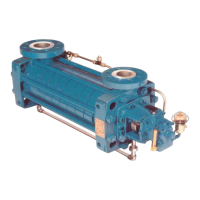
